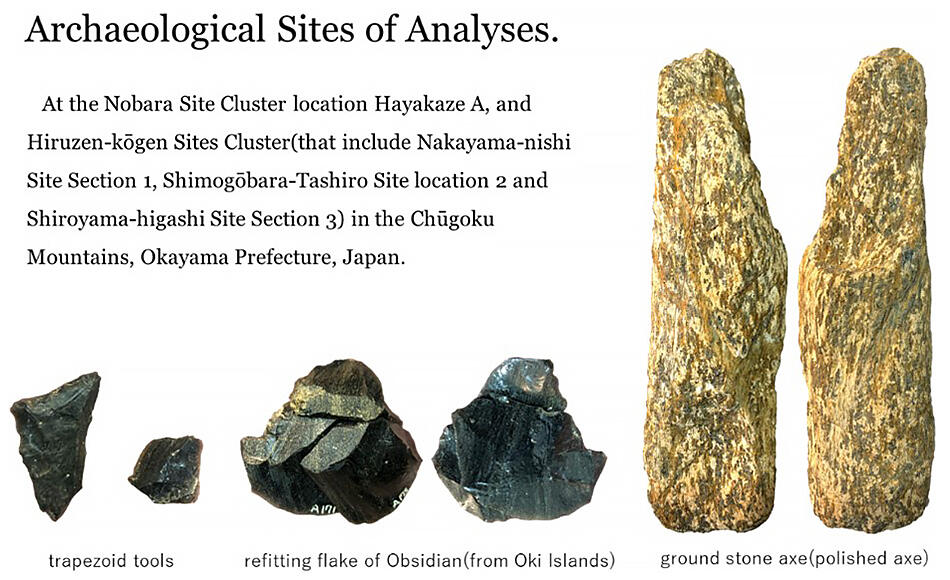A joint research team with academic and non-academic members has performed species identification and radiocarbon dating analysis of carbonized wood excavated from Upper Paleolithic sites in Maniwa City and Niimi City, Okayama Prefecture. The analysis results reveal that it is the oldest dated site in the Kinki, Chugoku, and Shikoku regions. It is also one of the oldest archaeological sites, stone tool assemblages, and traces of human life in the Japanese archipelago.
Team members from Chuo University included visiting researchers Minoru Oyokawa and Shin Onbe from the Institute of Cultural Sciences and Professor Kenichi Kobayashi from the Faculty of Letters. Members from the University of Tokyo's Museum included Professor Minoru Yoneda and Special Researchers Hiromasa Ozaki and Takayuki Omori. Non-academic members included Katsuya Kobayashi from the Paleo Labo, Yoshikuni Kojima; General Deputy Counselor of the Okayama Prefectural Ancient Kibi Cultural Properties Center, and Tomoka Nada; Chief Director of Matsue City's Culture, Sports and Archaeological Properties Division.
Along with dating the sites, the results of the tree species identification also support a pollen analysis from a previous study. The group's findings suggest that the climate and vegetation in the area (temperate deciduous trees like Prunus) were warmer relative to the coldest climate and vegetation (subarctic conifers) of the Last Glacial Maximum (about 25,000 to 20,000 years ago).

Provided by Chuo University
Until now, the Paleolithic period has been regarded as an ice age with a cold and harsh climate. However, these findings suggest this view of time and history needs to be revised.
Paleolithic period carbonized wood was excavated along with stone tools from a site previously excavated by the Okayama Prefectural Board of Education and the Okayama Prefectural Ancient Kibi Cultural Properties Center. The carbonized wood was sampled and analyzed for species identification by the Paleo Labo and then radiocarbon dated using an Accelerator Mass Spectrometer (AMS) owned by the University Museum of the University of Tokyo.
The cluster of sites at Hiruzen Kogen (Nakayama-Nishi Site, Shimogoharatashiro Site, Shiroyama-Higashi Site) are stone tool assemblages consisting mainly of trapezoidal stone tools and edge-ground stone axes.
Based on the Nakayama-Nishi site, which has the highest reliability for its consistent radiocarbon dating, the returned values of between 34,000 to 36,000 years old are the oldest reliable radiocarbon dates in the Kinki, Chugoku, and Shikoku regions. It was predicted there would be a shift from a temperate climate and vegetation that matched these temperatures (Prunus, Quercus, Fagus, etc.) during the period dating back to around the 28,000s to a subarctic climate and vegetation (Picea, Pinus, Abies, etc.) toward the Last Glacial Maximum (LGM). This value is consistent with the National Museum of Japanese History's database, which covers the entire Japanese archipelago and also corroborates the results of the pollen analysis. This was especially true south of latitude 36 degrees north (mainly western Japan).
These results suggest that regional trends and changes need to be carefully reconstructed. How did anatomically modern hominids (Homo sapiens), who were the first to reach and successfully establish themselves on the uninhabited Japanese archipelago, adapt to their new location, discover livable areas, and begin living there? What were their cultural characteristics, and what social relationships did they establish to achieve them? We now know that some of the oldest archaeological sites for answering questions like these remain in the Chugoku Mountains, centered around Hiruzen Kogen.
The group's findings indicate that it is vital to reconstruct the paleoenvironment, including eras, climates, vegetation, fauna, and sea level, through various physical and chemical analyses, including identifying carbonized wood species and performing radiocarbon dating analysis. They will continue this crucial human historical research through fieldwork in the Chugoku Mountains.
This article has been translated by JST with permission from The Science News Ltd.(https://sci-news.co.jp/). Unauthorized reproduction of the article and photographs is prohibited.




